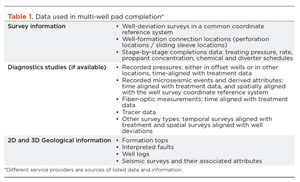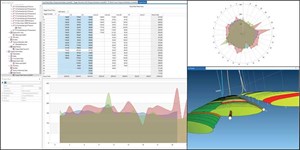Innovative solution builds knowledge from diverse data sources
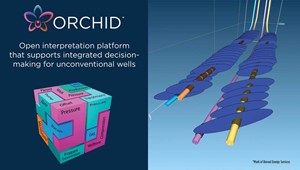
Many disruptors are reshaping the oil and gas (O&G) industry. Since 2008, unconventional (shale) oil production has radically altered global markets. The U.S. shifted from being an oil-importing nation to a major exporter because of unconventional oil’s productivity. Likewise, new digitalization technologies and tools enable operators to collect more diagnostic data on well completions and reservoir conditions. The volume of data collected is complicating engineers’ ability to analyze and understand this tsunami of information.
The primary challenge facing all operators is improving production and completion effectiveness. Much progress has been made over the last 10 years, but we have not fully realized the potential of scientific method-based analysis of all available well and diagnostic data, Table 1. The critical hurdles are:
- Managing fragmented and disjointed data from the myriad service providers, which is part of the tsunami of information
- Using fragmented software and tools available for unconventional well completions
- Connecting and balancing human time spent on engineering analysis and problem-solving.
Reveal Energy Services (Reveal) has invented new ways to build understanding and knowledge from collected data using interactive interpretation software. This software accelerates the value discovery process for unconventional wells, making previously cost-prohibitive analyses feasible in everyday operations. The critical insight has been to focus on human factors in engineering analysis. Human interpreters are part of the analysis loop, and they must have features at their fingertips to efficiently distill knowledge from data and cost-effectively navigate all available measurements for unconventional well management. Throughout this article, the authors show examples from the Permian basin, using this new interactive interpretation software to solve critical engineering challenges.
ENGINEERING AND INTERPRETATION SOFTWARE
Orchid engineering software is developed by Reveal. This suite of tools focuses on solving engineering challenges, especially in unconventional well completion problems. It is useful across many engineering and data management projects. The key to Orchid’s versatility is the flexibility of its plug-in architecture and its ability to be extended, using common engineering tools, such as MATLAB and Python. Furthermore, the software and its data definitions are compatible with all major cloud environments used by operators—Microsoft Azure, Amazon AWS, IBM and Google.
Reveal is driving growth in the capacity to interpret unconventional field diagnostics in ways that were not possible previously. The company is committed to the long-term viability of this work. At present, we are opening the development process to operators, partners and independent professionals, and university researchers and students, through a managed beta program, starting in July 2020.
A BRIEF HISTORY
Many operators face similar problems with diagnostic data management and usage as those encountered by service providers. In particular, the issues are efficient use of limited engineering resources—under time and cost pressures—to extract knowledge from their data universes. A small, innovative, engineering service company encountered common problems in analyzing unconventional well completions during its early lifetime. This is the journey of Reveal.
Early-stage developments. In 2016, a few Statoil (now Equinor) scientists and engineers spun off a novel technology for estimating fracture geometries from offset pressure recordings in pad completions. The IMAGE Frac® technology was developed originally on Excel spreadsheets that were then matured by Statoil’s internal IT development staff into a web-based analysis platform. The Reveal team took over development of IMAGE Frac in July 2016.
The original web-based software was consistent with modern best practices and software architecture: a geographically distributed, fault-tolerant and scalable database; microservices implementing business logic; and a presentation tier optimized for browser-based delivery.
Accelerating pace of innovation. As commercial operations kicked off, project scope and complexity rapidly increased. New analysis features were developed, and the bar for visualization and reporting was raised continuously. Although implementation of the web-based software was excellent, it proved hard to keep up with the pace of innovation required in a rapidly growing start-up service company. New features had to be mocked-up, coded and unit-tested, integrated, deployed, and run through quality-assurance and user-acceptance testing for every step of innovation. The layers of interconnected systems, even in a well-designed web-based platform, limit the ability to innovate quickly for these dense engineering projects. This experience is likely familiar to both operators and service companies centered on web-based technology infrastructure for engineering analysis.
Rapid prototyping and consolidating lessons learned. To support the pace of innovation, and to ensure high-quality service delivery on the rapidly expanding work, the company chose a new approach to technology development. In late 2016, the operations team adopted a rapid-prototyping environment that they could program directly. Key to the success was selecting a commercially available and stable environment—MATLAB. It is designed specifically for engineers and scientists to integrate data and to build user-interfaces, analyses and plots. Many engineers are trained in the essentials of software development. This allowed the company to put the operations staff in the driver’s seat, with respect to solving customer problems and creating innovative technology, while eliminating potential bottlenecks between formal software development and service-delivery in operations.
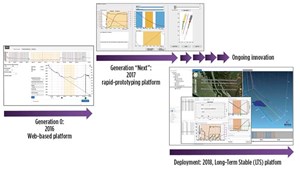
In parallel, the development team embarked on building a software platform to capture and consolidate the lessons learned in operations from the rapid-prototyping work. This project’s objective was to create a Long-Term Stable (LTS), maintainable software asset that would form the foundation of a scalable operations and service delivery organization into the future. The .NET Platform was selected, providing flexibility to deliver software from desktop to web applications. Figure 1 shows the software journey from the initial web-based deployment to the current LTS platform.
After several years of work, the Rapid-Prototyping and LTS approach resulted in a significant new interpretation software package—Orchid. Hard-won lessons in human-factors within the innovative development process enable Orchid to leverage local and remote hardware resources, and multiple physical displays, to significantly improve engineering users’ productivity.
TRANSFORMING DATA INTO VALUE
During their lifetimes, unconventional wells generate vast volumes of data, starting with drilling, then through completion and production. The well data are enriched with geology, economics and diagnostics. Today, it is common to have four-well pads, with 50 stages per well, in the Permian basin. Many operators are completing multiple pads over the course of a few months.
To benefit from all these data, a comprehensive data deep-dive is required. It follows four basics steps: 1) data loading; 2) data QC & cleansing; 3) data fusion; and 4) value discovery. In practice, this requires the engineering team to sift and sort through 200+ individual files per pad, and potentially many more when trying to understand underlying relations—for example, the impact of nearby parent wells on the completion and production performance of child wells. After the initial load, the data must be quality-controlled and corrected. The next, most challenging step is data fusion, where multiple data sources are linked and cross-referenced, thus creating an integrated data structure. This structure allows engineers to uncover trends and relations that are not present in primary data sources on their own.
Data fusion is extremely important. The most valuable lessons can be retrieved at the intersection of data sources. The Orchid workflow is designed to guide engineers though this full process and get to the value discovery quickly. Engineers have full control in interacting with the data in a very visual, very intuitive way.
DATA LOADING
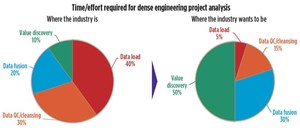
Many different data sources are loaded—one is time series data. Although it sounds simple, it can be quite challenging. For example, data recorded at one-second intervals, covering several weeks, quickly results in memory issues with software like Excel. Often, time data presented in ASCII format lack a recorded time reference, e.g. the data for a project are stored in local time, a different time zone, elapsed time from job start, or referenced to the system time of the acquisition computer. In addition, these time series data may need to be corrected for daylight savings time. Time synchronization issues are even more insidious, when data are acquired by two different vendors—treatment data from a pressure pumping company and offset pressure from an independent gauge vendor. Identifying the appropriate pressure response in the offset well that accurately aligns with the frac start/stop times of a given stage can be difficult.
Orchid provides comprehensive, interactive, and human-centric user interfaces to integrate data in multiple time zones and map the data to a common global time reference. Templates support importation and management of large data sets. To simplify repetitive tasks and reduce the engineer’s efforts, automation in various forms is built into Orchid. The automation is incorporated as auditable, transparent and reproducible functions. Engineers can focus on critical analysis tasks and quickly distill knowledge from well or field data. The automation in data loading, alone, provides more than 90% reduction in an engineer’s non-productive time, Fig. 2.
QUALITY CONTROL AND CLEANSING
Anyone who has handled data realizes that quality control (QC) and traceability must be resolved before attempting any critical analysis. Beyond time alignment, there are a multitude of critical QC features that can be completed on the loaded data. Here, we will highlight the calculation of start/stop times for a given frac stage. Similar workflows can be deployed in Orchid to QC the input data and various computations resulting from them.
Typically, the frac engineer records the start and stop times for every stage as fracing progresses. The times are manually recorded and based on when the pumps are turned on and off for a given stage. Mismatched recorded start/stop times are noticed, when the times are compared with actual pump pressure and pumping rates. Manually correcting the start/stop times is time-consuming and often ignored. Problems occur in comparing diagnostic data—such as microseismic, DAS, DTS, or the pressure response from the offset parent well—with the treatment data, and in computing volumes pumped and proppant loading before seeing a fracture-driven interaction (FDI) event in the parent well. Based on lessons learned in analyzing over 15,000 stages, the software includes transparent, auditable algorithms that can help the user consistently select start/stop times of the measurements. The software provides interactive editing capabilities and the ability to fine-tune start/stop times for every stage, down to the second.
DATA FUSION TO CREATE AN INTEGRATED STRUCTURE
Time-based analysis on recorded pressures, rates, concentrations, diverters, fiber-optic signals, and other temporal information is normally done in a spatially unaware context. Temporal “events” are generated as output of these analyses and then later derived estimations, such as final fracture geometry and propagation through time, are blended into a spatial viewer to see if they “make sense.”
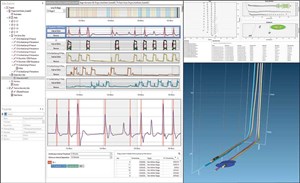
Similarly, spatial analysis occurs in a static context and is independent of the time-evolution of the pad completion, where results are presented as plat, cross-section, and gun-barrel views that lack temporal context. For example, these plots often obscure the impact of interactions, as zipper operations progress across multiple wells.
To understand how a temporal event (a frac hit or FDI) affects a spatial result (an offset well trajectory), it is critical to understand the spatial-temporal relation. Within Orchid, all temporal and spatial data are fully aware of one another, Fig. 3. The underlying data structure and interactive displays provide an “always” aware functionality, connecting every temporal event with the relevant spatial information.
Visual tools, when coupled to quantitative analysis, accelerate the discovery of data relationships from collected data. This capability identifies, unambiguously, why a given order of operations (sequence in which stages on a multi-well pad are fraced) leads to a more, or less, severe FDI with a given parent well. The spatial-temporal relationship is not just qualitative, it can be studied numerically. Combining numerical and visual interpretation enables a more complete understanding of the mechanisms driving parent-child well interactions. Numerical results can be used to develop quantitative relationships to post-frac parent well performance.
Using Orchid, completion engineers can efficiently interpret data in a unified context. Engineers have a 360o perspective of operations, with interactive control of the temporal timeline. They can quickly understand the evolution of the fracture geometry and relate this to multi-physics observations from offset pressure, fiber optics and slow strain, acoustic fluid imaging, microseismic, and many other diagnostics. This adds further to efficiency gains and time reduction for the engineer. What took several hours, or days, can now be completed within a few minutes. With enhanced interpretation productivity, greater understanding and knowledge are realized from data sets.
VALUE DISCOVERY: ECONOMICS-DRIVEN WELL COMPLETIONS
Available with the software is the DSCVRi Desktop plug-in, a well-known grid and pivot-table interface with the ability to generate engineering plots interactively. This plug-in enables rapid aggregation of engineering analyses with production results and economics. Engineers can quickly gain a quantitative understanding of the relationships between completion size, fracture geometries, production volumes and well- and stage- level economics. This insight is enhanced by the software’s multi-project capabilities. Engineers can compare multiple pads in a flexible, intuitive environment.
Unconventional oil formations are complex and variable. Engineers can easily use Orchid to perform “look back” studies, to identify problems occurring in individual stages and across the field, Fig. 4. Stages with significantly higher breakdown pressures, stages where breakdown was not achieved, or stages with abnormal ISIPs, calculated net pressures, or total pump times, are easily identified for further study. As illustrated in Fig. 4, the inset image displays the filter for pump time from the pivot-grid analysis applied to the fracture geometry, with the color of each stage reflecting the pump time. Users can quickly identify whether there are geologic, stress or other reasons that caused excessive pump time.
Without an interpretation environment such as Orchid, this type of analysis is time- and cost-prohibitive for engineers. Early identification of stage and field problems supports proactive decisions and better cost management.
BUILDING A SOFTWARE AND DATABASE ECOSYSTEM
Historically, data exchange and inter-operability between different software solutions have been major challenges for operators. To ensure that the software is not adding to the problem and is a solution, the company has committed to an open-data format. The format will be published, and the reference implementation Application Programming Interfaces (APIs) will be provided. Also, Orchid offers native Software Development Kits (SDKs) for Python and MATLAB, allowing users to develop their own tools and analysis. Moreover, the software supports exports to flat data tables in CSV format, for a simple transfer into many industry-standard tools, including Excel, Spotfire and Tableau.
Orchid’s native data exchange format, iFrac, developed by Reveal, reflects the integrated data structure from all data sources. It has been designed to maximize its re-use and utility. iFrac is based on transparent standards, such as JavaScript Object Notation (JSON). It supports common corporate data-lake infrastructures, either on-premise or in the cloud. Companies can leverage this open format that integrates both temporal and spatial data sets in one location to do large-scale analyses that are independent of any specific vendor.
To further the commitment to open-data platform development, the company is partnering with the Open Subsurface Data Universe™ Project. This partnership will solidify data definition in the unconventional space, and promote an open, collaborative, and non-proprietary process for standardization of this information, and its reference implementations.
CONCLUSION
Unconventional resource development presents unique challenges. These wells generate more data per stage, and more wells per field, than at any point in history. Service companies and operators experience the same challenges in interpreting diagnostic data. Engineers need human-centric technology, in addition to machine learning and A.I. algorithms, that can manage the volume and varying data types generated when developing these assets.
More than ever, it is vital to use the best software to manage the data tsunami created by digitalization. Without purpose-built interpretation tools, many analyses are cost-prohibitive to perform. To be more productive, engineers want deeper, more insightful views of all available data, not just a superficial look. The best results are achieved with expert engineering practices and scientific method-based analysis. Data are knowledge capital that must be fully utilized, if the industry is to realize the complete potential of unconventional wells and sustain shale’s competitive global position.
Reveal has achieved more than 80% gains in productivity while reducing engineers’ non-productive time by more than 90%. Orchid is bringing these efficiency gains and reduction in non-productive time, to ensure that we can collectively withstand the multitude of disruptors that are reshaping the O&G industry. A new beta program seeks to expand and optimize this software’s functionality.
- Digital transformation/Late-life optimization: Harnessing data-driven strategies for late-life optimization (March 2024)
- The reserves replacement dilemma: Can intelligent digital technologies fill the supply gap? (March 2024)
- Digital tool kit enhances real-time decision-making to improve drilling efficiency and performance (February 2024)
- Digital transformation: Digital twins help to make the invisible, visible in Indonesia’s energy industry (January 2024)
- Digital transformation: A breakthrough year for digitalization in the offshore sector (January 2024)
- Quantum computing and subsurface prediction (January 2024)

